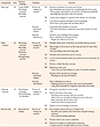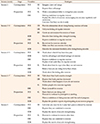Journal List > Korean J Adult Nurs > v.31(4) > 1130756
The purpose of this paper was to develop a stage-matched intervention based on the TransTheoretical Model (TTM) for elderly women with chronic back pain in the contemplation and preparation stage and evaluate its effectiveness.
Fifty elderly women with chronic back pain (experimental group, n=25; control group, n=25) was recruited from elderly welfare centers. The research was a nonequivalent control group pre- posttest experimental design. The process of change for exercise, exercise decisional balance, and exercise self-efficacy were used as interventional strategies. To examine the effectiveness of this program, the dependent variables, back pain and muscle strength, were measured before, immediately after, and 4 weeks after the intervention, from May 16 to August 26, 2016. The data were analyzed with the χ2 test, independent t-test, two way repeated measured ANOVA.
The process of change for exercise, exercise self-efficacy, and muscle strength were improved and back pain was decreased in the experimental group as compared with the control group.
The results of this study suggest that the stage-matched intervention was effective for improving the process of change for exercise, exercise self-efficacy, and muscle strength in elderly women with chronic back pain in the contemplation and preparation stage. It's wider implementation in community settings will promise promoted exercise activity among elderly women with chronic back pain.
This article is revision of the first author's doctoral dissertation from Kyungpook National University.
1. Oh KA, Park J, Jeon DJ, Han MA, Choi SW. Relationship between low back pain and health-related quality of life among some elderly. Journal of Agricultural Medicine and Community Health. 2012; 37(3):156–166. DOI: 10.5393/JAMCH.2012.37.3.156.

2. Ministry of Health and Welfare. Research on the actual condition of elderly 2014. Policy Report. Seoul: Ministry of Health and Welfare;2014. 12. Report No. 2014-61.
3. Edmond SL, Felson DT. Function and back symptoms in older adults. Journal of The American Geriatrics Society. 2003; 51(12):1702–1709. DOI: 10.1046/j.1532-5415.2003.51553.x.

4. Hyoung HK. Effects of a strengthening program for lower back in older women with chronic low back pain. Journal of Korean Academy of Nursing. 2008; 38(6):902–913. DOI: 10.4040/jkan.2008.38.6.902.

5. Ko JK. Comparing the effects of drug therapy, physical therapy, and exercise on pain, disability, and depression in patients with chronic low back pain. Journal of Korean Academy of Nursing. 2007; 37(5):645–654. DOI: 10.4040/jkan.2007.37.5.645.

6. Mailloux J, Finno M, Rainville J. Long-term exercise adherence in the elderly with chronic low back pain. American Journal of Physical Medicine & Rehabilitation. 2006; 85(2):120–126. DOI: 10.1097/01.phm.0000197580.64079.3d.

7. Choi I, Jang H, Kim S. Regression analysis of the relationship among the level of pain and dysfunction and psychological factors in patients with chronic back pain. Physical Therapy Korea. 2016; 23(1):38–45. DOI: 10.12674/ptk.2016.23.1.038.
8. Kwak H, Kim N. Analyses of studies on exercise therapy for middle-age women with chronic low back pain in Korea. Journal of the Korea Academia-Industrial cooperation Society. 2016; 17(6):389–399. DOI: 10.5762/KAIS.2016.17.6.389.

9. Kim HS, Park YS, Kim HK, Lee JS, Shin EH. Effect of trunk stabilization exercise program in elderly women with chronic low back pain. Journal of the Korean Gerontological Society. 2015; 35(4):1041–1059.
10. Choi BG, Yoon HK. The effects of aquatic exercise on functional fitness and pain rating scale in elders with low back pain. Korean Journal of Sports Science. 2011; 20(3):1393–1400.
11. Song M, Kim S. Effects of transtheoretical model based exercise behavior improving program on blood pressure and physical activity for older adults with hypertension. Journal of the Korea Contents Association. 2011; 11(12):364–377. DOI: 10.5392/JKCA.2011.11.12.364.
12. Kim MH. A Study on the relationships among the transtheoretical model construct on stage of change of exercise in the female elderly [dissertation]. Daegu: Kyungpook National University;2006.
13. Zhu LX, Ho SC, Sit JWH, He HG. The effects of a transtheoretical model-based exercise stage-matched intervention on exercise behavior in patients with coronary heart disease: a randomized controlled trial. Patient Education and Counseling. 2014; 95(3):384–392. DOI: 10.1016/j.pec.2014.03.013.

14. Kwon YJ. Development and evaluation of a stage matched exercise intervention program for elders-application of the transtheoretical model. Journal of Korean Academy of Community Health Nursing. 2002; 13(2):205–215.
15. Park JH, Kang SJ. The transtheoretical model of exercise behavior change: applications to decisional balance and stages of exercise change. Korean Journal of Measurement and Evaluation in Physical Education and Sport Science. 2001; 3(2):1–12.
16. CHang SO, Lee PS, Park EY. A study on the relationships among the influential variables on stage of change of exercise in the elderly. Journal of Korean Academy of Nursing. 2002; 32(5):609–623. DOI: 10.4040/jkan.2002.32.5.609.

17. Jackson R, Asimakopoulou K, Scammell A. Assessment of the transtheoretical model as used by dietitians in promoting physical activity in people with type 2 diabetes. Journal of Human Nutrition and Dietetics. 2007; 20(1):27–36. DOI: 10.1111/j.1365-277X.2007.00746.x.

18. Shirazi KK, Wallace LM, Niknami S, Hidarnia A, Torkaman G, Gilchrist M, et al. A home-based transtheoretical change model designed strength training intervention to increase exercise to prevent osteoporosis in Iranian women aged 40-65 years: a randomized controlled trial. Health Education Research. 2007; 22(3):305–317. DOI: 10.1093/her/cyl067.

19. Kim K. Effect of transdisciplinary cardiac rehabilitation program based on transtheoretical model on health behavior, self efficacy, and quality of life [dissertation]. Seoul: Seoul National University;2010.
20. Kim CJ. Process of change, decisional balance and self-efficacy corresponding to the stage of exercise behavior in patients with type 2 diabetes mellitus. Korean Journal of Adult Nursing. 2002; 14(1):83–92.
21. Schumann A, Nigg CR, Norman GJ, Rossi JS, Benisovich SV. Processes of exercise behavior change: redeveloping the scale. Annals of Behavioral Medicine. 1999; 21:suppl. 79.
22. Nigg CR, Rossi JS, Norman GJ, Benisovich SV. Structure of decisional balance for exercise adoption. Annals of Behavioral Medicine. 1998; 20:suppl. 211.
23. Marcus BH, Selby VC, Niaura RS, Rossi JS. Self-efficacy and the stages of exercise behavior change. Research Quarterly for Exercise and Sport. 1992; 63(1):60–66. DOI: 10.1080/02701367.1992.10607557.

24. Lee PS, Chang SO. The study on the effect of stage based exercise motivational intervention program for the elderly. Journal of Korean Academy of Nursing. 2001; (5):818–833. DOI: 10.4040/jkan.2001.31.5.818.

25. Scott J, Huskisson EC. Vertical or horizontal visual analogue scales. Annals of the Rheumatic Diseases. 1979; 38(6):560. DOI: 10.1136/ard.38.6.560.

26. Wang JM, Kim DJ. Assessment of the spinal pain using Visual Analogue Scale (VAS). Journal of Korean Society of Spine Surgery. 1995; 2(2):177–184.
27. Childs JD, Piva SR, Fritz JM. Responsiveness of the Numeric Pain Rating Scale in patients with low back pain. Spine. 2005; 30(11):1331–1334. DOI: 10.1097/01.brs.0000164099.92112.29.

28. Wadsworth CT, Krishnan R, Sear M, Harrold J, Nielsen DH. Intrarater reliability of manual muscle testing and hand-held dynametric muscle testing. Physical Therapy. 1987; 67(9):1342–1347. DOI: 10.1093/ptj/67.9.1342.

29. Prochaska JO, DiClemente CC. Stage and processes of selfchange of smoking toward an integrative model of change. Journal of Consulting and Clinical Psychology. 1983; 51(3):390–395. DOI: 10.1037/0022-006X.51.3.390.
30. U Y, Kwon M. The effects of lumbar stabilization exercise and strengthening exercise of lower extremity on pain and muscle strength of leg in patients with chronic low back pain. Journal of The Korean Society of Integrative Medicine. 2015; 3(2):47–54. DOI: 10.15268/ksim.2015.3.2.047.

31. Fetherman DL, Hakim RM, Sanko JP. A pilot study of the application of the transtheoretical model during strength training in older women. Journal of Women & Aging. 2011; 23(1):58–76. DOI: 10.1080/08952841.2011.540487.

32. National Health Insurance Service. Printed material: back pain rehabilitation exercise leaflets [Internet]. Seoul: National Health Insurance Service;2015. cited 2016 January 22. Avaliable from: http://www.longtermcare.or.kr/npbs/d/m/000/moveBoardView?menuId=npe0000000870&bKey=B0038&zoomSize=.
33. Calfas KJ, Long BJ, Sallis JF, Wooten WJ, Pratt M, Patrick K. A controlled trial of physician counseling to promote the adoption of physical activity. Preventive Medicine. 1996; 25(3):225–233. DOI: 10.1006/pmed.1996.0050.

34. Kim CJ. Analysis on priority of constraint factors in physical activity participation by elderly people: focused on sports club and homes for elderly people in some areas of Seoul. Journal of the Korean Gerontological Society. 2013; 33(3):563–580.
35. Song R, Ahn S. Effect of lumbar stabilization exercise on back pain, physical fitness, sleep, and depression in middle-aged women with chronic back pain. Korean Journal of Adult Nursing. 2008; 20(2):269–279.
- TOOLS
- ORCID iDs
-
Hyun-Ju Oh

https://orcid.org/0000-0002-9140-6940Soon-Rim Suh

https://orcid.org/0000-0003-4578-9685Mihan Kim

https://orcid.org/0000-0002-6039-4190 - Similar articles




 PDF
PDF ePub
ePub Citation
Citation Print
Print






 XML Download
XML Download